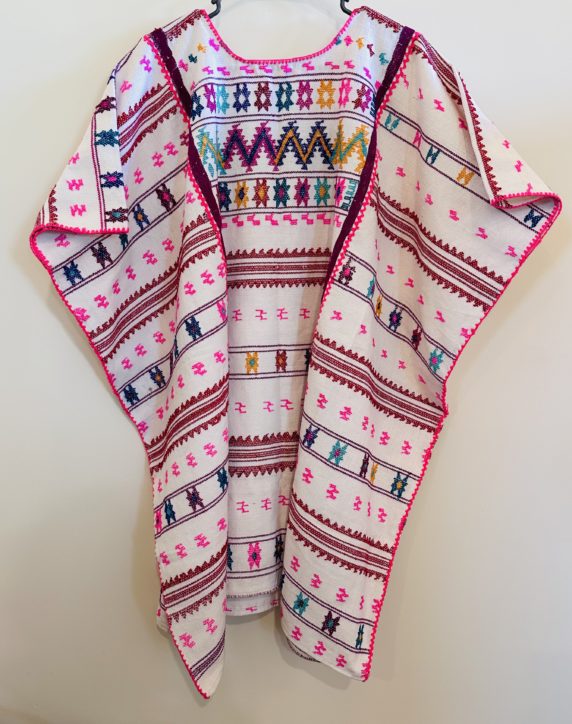I decided to have a very small New Year’s Eve birthday celebration, invite a few Zapotec friends and the family I live with to lunch, and prepare pozole. I made this in North Carolina for Dia de los Muertos, but adapted the recipe for ingredients I could find there.
Here, in the Teotitlan del Valle market, I could find fresh Mexican oregano, organic and native corn hominy made by a local family, and tender pork from the local butcher that cost a mere $7 USD for the best cut.
After three trips to the car to unload my shopping basket, I sat down at the corner market stand for fortification — a fresh juice cocktail with beets, pineapple, carrot and orange.
Almost everything here in the village market is criollo — or native species. The small heads of garlic come from the neighboring village of Tlacochuaya. You can only buy the heads with giant cloves at commercial grocery stores.
I did have a glitch in my preparation. My search for shelled pumpkin seeds (called pepitas) failed. So I bought whole seeds in a bulk bag from a spice and chili vendor. When I got home, I proceeded to try to take the skin off. The pumpkin seeds are essential to the green pozole because when ground, they become a natural sauce thickener.
Then my friend Lupita came over. Much easier, Norma, to toast the seeds on the comal, she told me, then the shell will come right off. She taught me how to toast until the seeds start to pop like popcorn. It took me two hours to yield 1/4 cup of shelled pumpkin seeds, the amount my recipe called for. She sat down to help me and in thirty minutes the amount doubled.
I love green pozole. And, I remembered how easy it was to make this one-pot meal in North Carolina. But, all fruits and vegetables here in Mexico need to be disinfected. I often rinse them several times to get rid of the soil. Picked fresh organic cilantro and radishes are sold roots and greens. Just to get the ingredients ready was another lesson in paciencia.
For this Green Pozole (pozole verde) recipe, I adapted ingredients and instructions culled from Rick Bayless, Mama Latina Tips, and Food Network. I prepared the pork-chicken/onion/garlic mix in a crock pot first, cooking for six hours.
When lunch ended it was almost dusk. Lunch starts here around three or four o’clock and can end several hours later depending on the quantity of food and mezcal. We had our fair share of both.
For the next feast we would gather at 10:30 p.m. for a midnight meal with my host family to celebrate the New Year. This is a long-standing tradition in Teotitlan del Valle, along with the annual pilgrimage to Las Cuevitas.
For the interlude, I went up to the rooftop terrace to wait, climbed into the hammock, and gazed at this December 31 Supermoon. In the distance I could hear the village band playing at the sacred caves — Las Cuevitas. Cohetes, or firecrackers, exploded like gunshot at irregular intervals. Dogs howled. Probably a few coyotes, too.
On this first day of 2018, as my Teotitlan del Valle family and I sat around the table at lunch, we each shared our wishes for 2018. I wish for continued good health, for continuing to walk three to four miles a day with my adopted dogs, for nothing more than what I already have, except to see my son more often and perhaps the possibility of a man in my life. Vamos a ver!
As this year begins anew, as we each move through the passage of time, I wish for all of us a year of peace, satisfaction, contentment, love and abundance. There is nothing more important than the support of family and good friends.
Thank you all for following Oaxaca Cultural Navigator, for reading, for joining me to discover and explore textiles and natural dyes, and for caring about Mexico.
Happy New Year. Feliz Año Nuevo.






















































Margarita Time: What is Cinco de Mayo?
This Friday, May 5, 2023, marks the 161st anniversary of Cinco de Mayo. Why do we celebrate with a Margarita or Corona or Modelo Negro? More than party time, Cinco de Mayo is an important event in U.S. history, and not so much for Mexico. Read on to find out more.
First of all, it’s time to know that May 5, Cinco de Mayo, is NOT Mexican Independence Day, which is September 16, 1810, celebrating the separation of Mexico from Spanish rule.
Nevertheless, Cinco de Mayo marks a significant date in history when the French army was defeated in Puebla on May 5, 1862, marking an important symbolic moment to curtail Napoleon Bonaparte’s designs on establishing a monarchy in North America. When you visit Puebla you can still see the bullet holes in front of the house occupied by General Ignacio Zaragoza.
Most of us know Cinco de Mayo as a U.S. celebration of Latino culture. There are 62.1 million Latinos living in the U.S. according to the 2020 census representing 19 percent of the population, making it the nation’s second largest racial or ethnic group according to the Pew Research Center.
Perhaps we know Cinco de Mayo as the name of a favorite local Tex-Mex restaurant, or the promotion of a favorite beverage accompanied by guacamole. (Avocados are imported from Michoacan, Mexico.) At the end of this week, many will of us will welcome the occasion to have a party and raise a toast to our southern neighbor with a beer or Margarita. What are you doing for Happy Hour on May 5?
But there’s much more to it than that, according to historian David Hayes-Bautista, as reported by CNN and Reza Gostar in GlendoraPatch. It notable that Cinco de Mayo was a rallying cry in the U.S. by Latinos against the elitist French monarchy, which was sympathetic to the Confederacy during the Civil War. At that time, Latinos sided with the Union, fearing that a Confederacy win would expand slavery to include them. If Blacks could be enslaved, so could brown and indigenous people, too.
Puebla is Angelopolis, City of Angels
Dr. Hayes-Bautista, who is director of UCLA’s Center for the Study of Latino Health and Culture, has uncovered the first groundbreaking research that links the celebration of liberation for Mexicans with the U.S. Civil War and the hope that the Union would prevail. The win at the Battle of Puebla by the Mexican freedom fighters against the elitists energized many Americans early in the war when the Confederacy was powerful. This was especially significant for Latinos, since much of the American Southwest was populated by those with Spanish and Mexican heritage.
So, as you raise your glass with a hearty Salud, recall that Latinos volunteered to serve in the Union Army in order to preserve freedom, independence, and fight for racial justice.
Watch this YouTube video to know more about Cinco de Mayo as told by Dr. David Hayes-Bautista.
Quick footnote: I’m recovering from surgery at University of New Mexico Medical Center and in Albuquerque with my son and daughter-in-law. All went well. No pain. No opioids. Amazing surgical team. No worries. I’m hoping to go home to Taos this weekend. The kids are going out for Cinco de Mayo. I’ll be here, resting! My surgeon is Latina as is her medical resident. We’ve come a long way, but not far enough!
Like this:
2 Comments
Posted in Cultural Commentary, Mexican Immigration
Tagged Battle of Puebla, blogsherpa, celebration, Cinco de Mayo, Civil War, culture, history, Mexico, Oaxaca